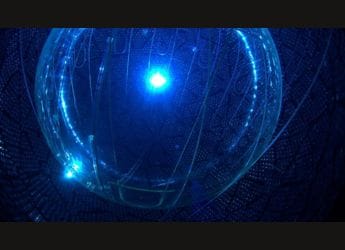- Home
- Science
- Science News
- Scientists Create Metallic Hydrogen, a Possible Superconductor, Ending Quest
Scientists Create Metallic Hydrogen, a Possible Superconductor, Ending Quest
Photo Credit: Isaac Silvera
US scientists have succeeded in squeezing hydrogen so intensely that it has turned into a metal, creating an entirely new material that might be used as a highly efficient electricity conductor at room temperatures.
The discovery, published in the journal Science on Thursday, provides the first confirmation of a theory proposed in 1935 by physicists Hillard Bell Huntington and Eugene Wigner that hydrogen, normally a gas, could occur in a metallic state if exposed to extreme pressure.
Several teams have been racing to develop metallic hydrogen, which is highly prized because of its potential as a superconductor, a material that is extremely efficient at conducting electricity.
Currently, superconductors such as those used in a magnetic resonance imaging, or MRI, machines must be cooled with liquid helium to keep them at extremely low temperatures, which is costly.
"This is the holy grail of high-pressure physics," Harvard physicist Isaac Silvera, one of the study's authors, said in a statement. "It's the first-ever sample of metallic hydrogen on Earth, so when you're looking at it, you're looking at something that's never existed before."
David Ceperley, a physics professor at the University of Illinois Urbana-Champaign who was not involved in the research, said the discovery, if confirmed, would end a decades-long quest to see how hydrogen can become a metal, adding to the understanding of the most common element in the universe.
To achieve this feat, Silvera and post-doctoral fellow Ranga Dias squeezed a tiny hydrogen sample at more than 71.7 million pounds per square inch (32.5 million kg per 6.5 square cm), greater than the pressure at the centre of the Earth.
The scientists created this force using synthetic diamonds mounted opposite each other in a device known as a diamond anvil cell. They treated the diamonds with a special process to keep them from cracking, a problem that has foiled prior experiments.
"This is just at the point when the diamonds are about to crack," Ceperley said. "That is why it's taken so long. Silvera had new ways of shaping the diamonds and polishing them so they wouldn't break."
A key question is whether the pressurized hydrogen maintains its metallic properties at room temperature, which would make it extremely useful as a superconductor.
Both Ceperley and Silvera believe this will be the case, but it still needs to be proven.
© Thomson Reuters 2017
Get your daily dose of tech news, reviews, and insights, in under 80 characters on Gadgets 360 Turbo. Connect with fellow tech lovers on our Forum. Follow us on X, Facebook, WhatsApp, Threads and Google News for instant updates. Catch all the action on our YouTube channel.
Related Stories
- Samsung Galaxy Unpacked 2025
- ChatGPT
- Redmi Note 14 Pro+
- iPhone 16
- Apple Vision Pro
- Oneplus 12
- OnePlus Nord CE 3 Lite 5G
- iPhone 13
- Xiaomi 14 Pro
- Oppo Find N3
- Tecno Spark Go (2023)
- Realme V30
- Best Phones Under 25000
- Samsung Galaxy S24 Series
- Cryptocurrency
- iQoo 12
- Samsung Galaxy S24 Ultra
- Giottus
- Samsung Galaxy Z Flip 5
- Apple 'Scary Fast'
- Housefull 5
- GoPro Hero 12 Black Review
- Invincible Season 2
- JioGlass
- HD Ready TV
- Laptop Under 50000
- Smartwatch Under 10000
- Latest Mobile Phones
- Compare Phones
- Redmi Note 15 5G
- Redmi Note 15 Pro 5G
- Redmi Note 15 Pro+ 5G
- Lava Play Max
- Poco C85 5G
- Honor Magic 8 Lite
- Jolla Phone
- Realme P4x 5G
- Asus ProArt P16
- MacBook Pro 14-inch (M5, 2025)
- OnePlus Pad Go 2
- Poco Pad M1
- Just Corseca Skywatch Pro
- Honor Watch X5
- Acerpure Nitro Z Series 100-inch QLED TV
- Samsung 43 Inch LED Ultra HD (4K) Smart TV (UA43UE81AFULXL)
- Asus ROG Ally
- Nintendo Switch Lite
- Haier 1.6 Ton 5 Star Inverter Split AC (HSU19G-MZAID5BN-INV)
- Haier 1.6 Ton 5 Star Inverter Split AC (HSU19G-MZAIM5BN-INV)

















